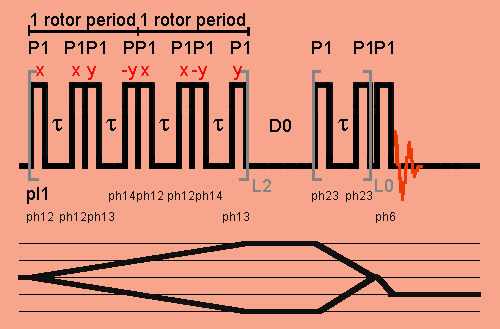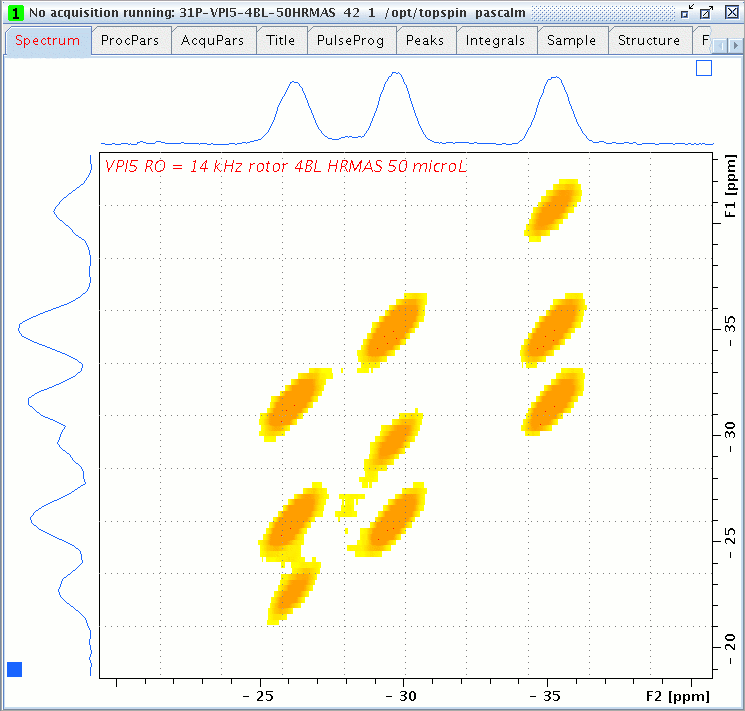
BABA 2rotations: 1D/2D double quantum excitation, 2 rotor period, BABA pulse program for TopSpin2.1

Since non-phase cycling is applied to the BABA reconversion pulse, four-phase cycling is applied to the BABA excitation pulse for filtering DQ coherences and four-phase cycling is applied to the detection pulse P1 for selecting the 0Q -> -1Q coherence order jump.
;baba2rot (TopSpin 2.0) ;2D SQ-DQ correlation experiment for 2 rotor periods recoupling using BABA ;for weaker dipole dipole interactions, e.g. 19F ;compensated for pulse imperfections ;M. Feike, D.E. Demco, R. Graf, J. Gottwald, S. Hafner, and H.W. Spiess JMR A 122, 214-221 (1996) ;written by JOS, 11/12/03 ;parameters: ;d1 : recycle delay ;d0 : incremented delay (2D) [1 usec] ;pl1 : for 90 degree BABA pulses ;p1 : 90 degree pulse (in BABA sequence and in presaturation sequence) ;l1 : number of rotor cycles for recoupling, any integer ;l2 : l2*2=l1=(number rotorcycles) ;d20 :delay between saturation pulses ;l20 : # of pulses in saturation pulse train, 0 if undesired ;cnst31 : rotation rate in Hz ;ns : n*16 ;FnMode: States-TPPI or STATES ;$COMMENT=SQ-DQ correlation experiment with BABA for 2 rotor periods ;$CLASS=Solids ;$DIM=1D ;$TYPE=direct excitation ;$SUBTYPE=homonuclear correlation ;$OWNER=Bruker define delay tau "tau=0.5s/cnst31-p1*2" "d0=1u" "in0=1s/cnst31" "l1=l2*2" "l0=2*l1" ;cnst11 : to adjust t=0 for acquisition, if digmod = baseopt "acqt0=1u*cnst11" ze 1 d1 #ifdef presat ;set with -Dpresat pres, d20 ;delay between saturation pulses (p1 pl1 ph1):f1 ;saturation loop if required lo to pres times l20 #endif /* presat */ 2 d1 5 (p1 pl1 ph12):f1 ;DQ excitation block tau (p1 ph12) (p1 ph13) tau (p1 ph14) (p1 ph12) tau (p1 ph12) (p1 ph14) tau (p1 ph13) lo to 5 times l2 d0 ;evolution of DQ coherence if more than 1 rotor period DQ excitation 7 (p1 ph23 ipp23) ;DQ reconversion if more than one rotor period ;increment phase ph23 pointer tau (p1 ph23 ipp23) ;increment phase ph23 pointer lo to 7 times l0 (p1 ph6):f1 go=2 ph31 d1 mc #0 to 1 F1PH(ip12 & ip13 & ip14, id0) HaltAcqu, 1m exit ph1= 0 ;for saturation pulse ph12=(8) 0 2 4 6 ; x y -x -y ph13=(8) 2 4 6 0 ; y -x -y x ph14=(8) 6 0 2 4 ;-y x y -x ph23= 0 0 1 3 0 0 3 1 ; x x y -y x x -y y ph6 = 0 0 0 0 1 1 1 1 2 2 2 2 3 3 3 3 ph31= 0 2 0 2 1 3 1 3 2 0 2 0 3 1 3 1

31P BABA2rot DQ-SQ spectrum of VPI-5 zeolite; rotor spinning speed: 14 kHz.
Pulseprogram parameters for baba2rot.ppm:
| General | |
| PULPROG | baba2rot.ppm |
| TD | 2048 |
| NS | 128 |
| DS | 0 |
| SWH [Hz] | 12500.00 |
| AQ [s] | 0.0819700 |
| RG | 4 |
| DW [µs] | 40.000 |
| DE [µs] | 6.50 |
| CNST11 | 0.0000000 |
| CNST31 | 14000.0000000 |
| d0 [s] | 0.00000100 |
| D1 [s] | 10.00000000 |
| D20 [s] | 0.10000000 |
| in0 [s] | 0.00007143 |
| l0 | 28 |
| l1 | 14 |
| L2 | 7 |
| L20 | 20 |
| ST1CNT | 85 |
| ZGOPTNS | -Dpresat |
| tau [µs] | 0.00003171 |
| Channel f1 | |
| NUC1 | 31P |
| P1 [µs] | 2.00 |
| PL1 [dB] | 5.00 |
| PLW1 [W] | 110.88822174 |
| SFO1 [MHz] | 202.4830869 |
Acquisition parameters:
| F2 | F1 | |
| Experiment | ||
| PULPROG | baba2rot.ppm | |
| AQ_mod | DQD | |
| FnMODE | States-TPPI | |
| TD | 2048 | 170 |
| NS | 128 | |
| DS | 0 | |
| TD0 | 1 | |
| Width | ||
| SW [ppm] | 61.7336 | 69.1402 |
| SWH [Hz] | 12500.000 | 13999.720 |
| IN_F [µs] | 71.43 | |
| AQ [s] | 0.0819700 | 0.0060715 |
| Nucleus1 | ||
| NUC1 | 31P | 31P |
| O1 [Hz] | -1584.14 | -1584.14 |
| O1P [ppm] | -7.824 | -7.824 |
| SFO1 [MHz] | 202.4830869 | 202.4830869 |
| BF1 [MHz] | 202.4846710 | 202.4846710 |